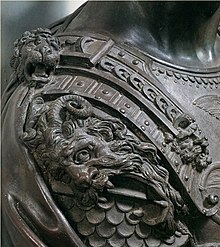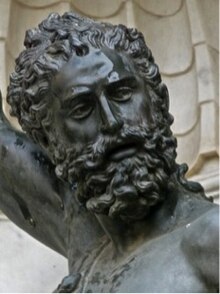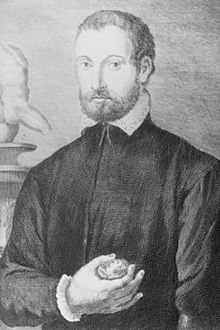Portraits of Benvenuto Cellini
However, due to a few known portraits from the 17th – 20th century, where the artists drew Cellini's facial traits from their imagination, as well as because of past posthumous erroneous attributions, there is a level of confusion on this subject.[5] Although most personalities, including Cellini himself, appear in the fresco undersigned by Vasari with their real names, Plon nevertheless cast doubt over the caption's accuracy.In 1829 Francesco Tassi claimed that Collyer had been commissioned to make the engraving of "portrait Benvenuto Cellini" by the British publisher "Nugent".Upon his return from France to his hometown Florence in 1545, Benvenuto cast a bronze bust of Cosimo I Medici, the Grand Duke of Tuscany.The animalistic features of the Satyr, in combination with the human face, acquire an even more explicit hint at Cellini's personality than the semiotic value of the lion image.[14] An inscription bearing the words "TE FILI SIQUIS LAESERIT ULTOR ERO"[15] is carved on the marble cartouche beneath Jupiter's niche on the base of Cellini's "Perseus".The French 19th century editor Eugene Plon, besides mistakenly attempting to re-attribute personages of Vasari's fresco in Palazzo Vecchio, entered into the field of public awareness an artifact, known today as the "porphyry portrait of Benvenuto Cellini".[18] Plon claims that "several portraits made on porphyritic stone are kept in the Pitti Gallery" and that "all of them date back to the same epoch as regards the time of their creation.Although in 2007, the Parisian auction house "Drouot" sold a picture attributed as "Portrait of Monsieur Strozzi" by an unknown follower of Cornelius de Lion.It is not known what sources Giuseppe Zocchi used in his 18 century for the inspiration, but the image of "Cellini" he created stands very wide apart from the portrait of Benvenuto on Vasari's fresco.(1837) King of France Louis-Philippe purchased the Marrel Brothers Cup in order to hand this work of art to his son Louis, Duke of Nemours as a gift.Goldsmiths and companions Antoine-Benoit-Roch and Jean-Pierre-Nazaire Marrel produced their masterpiece on a wave of inspiration from Cellini's so-called "Augsburg's Cup" that was purchased by the Louvre Museum in 1832.[22] The Italian sculptor Vincenzo di Marco Fabio Apolloni (‘Gajassi’) created a marble bust of Benvenuto Cellini in 1844.Museum Capitoline, Rome The architect Giorgio Vasari and his successor Bernardo Buontoletti left 28 spare niches in the walls of colonnade of the Uffizi palace.










Benvenuto CelliniGiorgio VasariPalazzo VecchioBartolomeo AmmannatiJoseph CollyerFrancesco TassiRaffaello Sanzio MorghenFranceFlorenceRenaissanceRoyal Library of TurinPerseus"Salt cellar of the King Francois I"Château d’EcouenFrancesco SalviatiGiuseppe ZocchiFrancesco AllegriniLouis-PhilippeLouvre MuseumUlisse CambiRaffaello RomanelliPonte Vecchioliterary self-portrayalterribilitàNymph of FontainebleauCellini Salt CellarPerseus with the Head of MedusaAscanioThe Affairs of CelliniThe Firebrand of FlorenceThe Magnificent AdventurerA Violent LifeCelliniCellini's halo